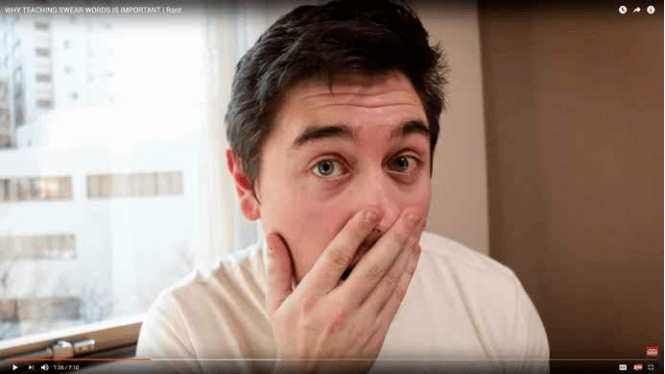Issue:

From his video “Why Teaching Swear Words is Important”
The future of the media is you(tube)
by RICHARD SMART
Despite recent films extolling the heyday of investigative journalists, like the Boston Globe team that took on the Catholic church in the film Spotlight, traditional media jobs are no longer thought of as desirable by young people entering the workforce. In fact, in a CareerCast.com ranking of the worst professions to enter, a career in newspaper journalism topped the chart. In No. 3 was broadcaster, only barely beaten by the logger profession in second. There is one job in media, though, that is among the most desired career choices for 21st century youth: the YouTube star.
A look into the inner workings of the platform in Japan suggest that these starry eyed job hunters, who likely see the platform offering a path to easy money and a lavish lifestyle, may want to rethink their ambitions. Earnings are opaque, trolls are common, a jimusho system that is as impenetrable as that in Jpop controls the trajectory of its stars, and just as the biggest newspapers of the world find themselves at the whim of the Facebook algorithm, so do “vloggers” video bloggers face online processes that can make or break their ad revenue in any given month.
So why are 400 hours of video worldwide getting uploaded to the platform every minute? Those involved on the ground speak of a sense of community and an opportunity to create, while those in what is derogatorily referred to as “legacy media” view video whether on YouTube or other platforms as a way of reaching millennials.
ESCAPING THE TROLLS
“Endless September” is a phrase rarely heard outside geek circles. It refers to a phenomenon from the early days of the internet, when sophisticated, high context conversations on chatrooms would be disrupted once a year, then more often, then always, by the inane, the misinformed and trolls. Why September? That is when students arrived online, getting free online access at their universities. As more joined the internet, so did the tendency for dull conversation and trolling increase, making the September problem a year round one.
Japan had its own endless September. Hikosaemon, a YouTuber with 35,000 subscribers who has been active on the YouTube site since around the time of its launch, joined to avoid the trolling and banality of comments sections in other areas of the internet. “It was a time when news forums turned into rage spaces for the expat community to vent,” he said. “I originally used YouTube to try and reach out to other people who shared my interest in Japanese news without the rage. Since the 1990s I was reading Japanese news online, and watching people using YouTube to talk about American news. I was more interested in discussion than foreigner fights, where trolls dominate the forums.”
YouTube gave him a chance to be a “guide” to news stories from Japan, with an overseas to Japanese audience ratio of around 70:30. “I found it was a way of engaging with people on my own terms,” he said. “What I do complements old media. There has been an observable decline at times in the quality of coverage in some parts of the media, and people online are looking for verification; they are asking if they can trust what they are reading.”
Through the ads that appear alongside his videos, Hikosaemon makes just enough to pay for broadcast equipment, but little more. He declined to go on the record with his profession and real name as a precaution against potential trolling and harassment. This was true of the many who spoke with the Number 1 Shimbun who declined to release personal details, and all said that it simply wasn’t worth the hassle. The threat of trolls seeking out your identity to harass you can turn a hobby, or possible career, into the sort of irritant or worse that is all too familiar to many journalists at the FCCJ.
MONETIZING THE STREAMS
But there are those who have become professional YouTubers over the years, taking advantage of the platform’s AdSense program that allows contributors to share a slice of the advertising pie, while download speeds have taken streaming main stream. With increased viewer figures have come sponsorship deals, paid contracts with talent agencies and a chance to crowdfund channels through Patreon, a platform that allows fans to contribute money to those online that they support.
Up in Tohoku, Chris Broad’s Abroad in Japan channel has amassed more than a quarter of a million subscribers, attracts hundreds of thousands of views and allows him to live off of his earnings. “You still need to make something that is informative and entertaining or ideally both with a clear demo graphic in mind,” he says of his success. “But I’d say if you were consistent in uploading and delivering quality content,250,000 subscribers is achievable in 18 to 24 months.”
Broad says many in the industry are signing up with companies and agencies to make a living, while he has followed a more independent path. “Most YouTubers make an income from three sources: YouTube ad revenue, merchandise and sponsors, ” he says. “I’ve dabbled with all three, but they’re all fairly unreliable. YouTube ad revenue can be fairly unpredictable and goes up and down throughout the year according to advertising spending, which is typically higher around the end of the year.”
Three of the big English language YouTube channels in Japan belong to Canadians Micaela Braithwaite (270,000 subscribers) and Sharla (467,000), and the American wife/Japanese husband team Rachel and Jun (679,000). All three are represented by Yoshida Masaki, a talent agency that refused to give access to its stars, citing their inability to answer questions such as “How has YouTube changed your life” within a definite time period because of commitments. The agency did, however, answer questions about those it represents.
“There is not much difference between the way we treat YouTube creators and our other staff,” an official at the company said. “We praise them when they deserve praise and scold them when they deserve scolding. But whichever we do, it is with love.”
Yoshida Masaki says that it believes YouTube is heading down a sustainable path. Many of the accounts may at base be seeking out just clicks, according to the company, and are unlikely to stand the test of time. Other accounts though, operated by people with a creative drive that is about more than money and an understanding of the platform they are working on, are the future for the platform.

from her video “Thank You for 5 Years on YouTube”

“Pros and Cons of Traveling in Japan”
LEARNING FROM SCRATCH
Can major international publications learn from the YouTubers? The Guardian thinks so. Christian Bennett, global head of video and audio for the Guardian, says the videos the site produces attract more women and a viewership about 15 years younger than the average reader. “We have to find a way to engage with that audience if we want a future audience for the Guardian,” he said. “They are commercially more valuable in terms of preroll ads, and if you’re really serious about digital news gathering you have to be in video. It’s like color photography once was for newspapers.”
With their markedly higher quality, the Guardian’s videos have won numerous awards. Most recently, the Grierson Trust nominated the company’s We Walk Together, a 17 minute piece on the journey of a Syrian refugee family’s journey across Europe, for a Best Documentary on Current Affairs award. Other nominated films came from the BBC and ITV, Britain’s main terrestrial networks.
Those on YouTube, though, are more focused on community than mass appeal. “It is not that we are going to become big media,” Hikosaemon said. “But all these interest communities that have videos of broadcast quality will get places on platforms [now being developed by Silicon Valley companies] for their specialist channels.”
YouTube itself sees opportunities both with major companies and the upstarts. “YouTube wants to be the preferred destination where fans and video creators engage,” Ayako Kono, a spokeswoman for the company said. Those video creators need not have a DIY spirit. “Recently, respected animation houses Nippon Animation and Kadokawa have worked with YouTube to bring their content onto our platform, allowing more fans around the world to view their productions than ever before.”
The company aims to be in virtual reality on cellphones and anywhere else that people view video, Kono said. So is this the future? Broad believes it may well be, but says that the main risk is that the company changes in ways that will alienate those contributing and cause them to jump ship.
“Given that YouTube is a Silicon valley company, it's very proactive when it comes to innovation,” he says. “I’m all for innovation, but it can make you a bit anxious when they make dramatic changes suddenly that affect creators.”
Richard Smart covers Japanese business, science and the economy for publications around the world.

